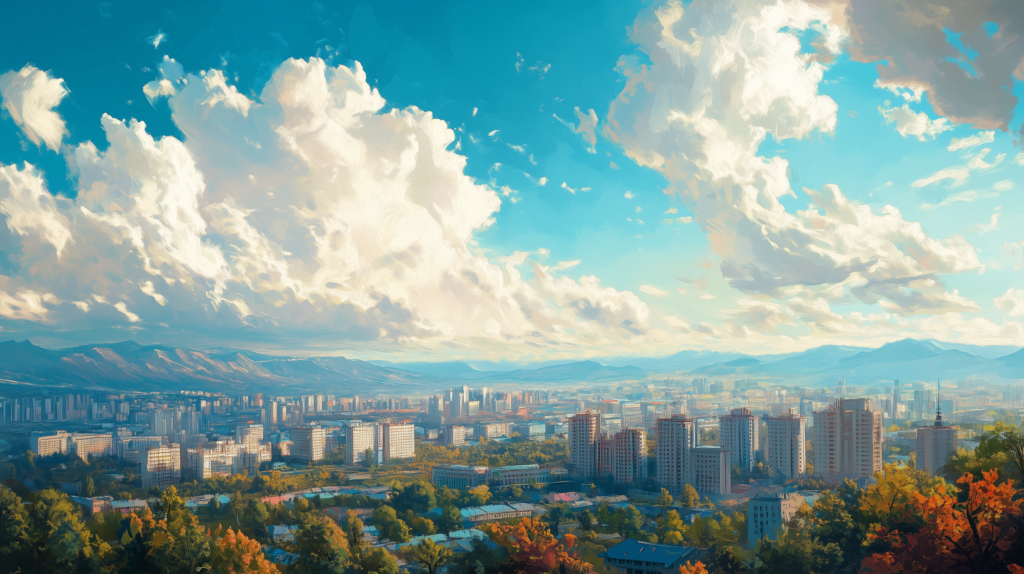
Bishkek, the capital of Kyrgyzstan, is a vibrant and modern city surrounded by majestic mountain ranges and lush parks. The city is renowned for its rich history and culture, featuring numerous monuments and architectural landmarks. Here, one can find a harmonious blend of Soviet architecture, national cultural monuments, and modern elements.
Main Attractions in Bishkek:
- Ala-Too Square: The central square of Bishkek, Ala-Too, is the city’s main symbol and venue for state and public events. Here you can find:
- Manas Monument: A sculpture of the legendary Kyrgyz hero Manas, symbolizing the independence and strength of the Kyrgyz people.
- State Historical Museum: Located on the square, it houses exhibits dedicated to the history and culture of Kyrgyzstan. The square is a popular spot for walks, especially in the evening when the lights come on and light shows with fountains are organized.
Independence Monument and National Flag: Also on Ala-Too Square is a monument commemorating Kyrgyzstan’s independence, proclaimed in 1991. Nearby stands a giant flag of Kyrgyzstan, one of the largest in Central Asia, with a flagpole reaching 45 meters in height.
Abdyla Maldybaev Opera Theater: One of the most beautiful buildings in Soviet style in Bishkek, the Kyrgyz State Academic Theater of Opera and Ballet impresses with its columns and monumental architecture. It hosts opera, ballet performances, and various cultural events.- White House: The residence of the President of Kyrgyzstan, known as the White House, is a massive building that once housed the Soviet administration. It is characterized by typical Soviet architecture and is surrounded by well-maintained green lawns. The White House is an important political symbol of the country, and the square adjacent to it often serves as a site for protests and demonstrations.
- Victory Park (Jengish Park): One of the largest parks in Bishkek, Victory Park was established in honor of the victory in World War II. At the center of the park stands a majestic monument in the shape of yurts, symbolizing the country’s heritage. It also features a memorial and an eternal flame commemorating Kyrgyzstani soldiers who fell in battle. This peaceful green space is perfect for strolls and relaxation under the trees.
- Central Mosque named after Imam Sarakhsi: Recently built, this magnificent mosque is the largest in Kyrgyzstan and one of the largest in Central Asia. It accommodates thousands of worshippers and features stunning architecture in traditional Islamic style with domes, mosaics, and minarets. The mosque has become a symbol of modern religious architecture in Kyrgyzstan.
- Osh Bazaar: One of the oldest and largest markets in Bishkek, Osh Bazaar immerses visitors in the atmosphere of an Eastern market. Here you can find fresh fruits and vegetables, spices, dried fruits, traditional Kyrgyz products, and souvenirs. It’s one of the best places to experience local cuisine, culture, and daily life.
- Kurmandjan Datka Monument: Located at the intersection of central streets, this monument honors Kurmandjan Datka, one of the most prominent women in Kyrgyz history, who governed southern lands in the 19th century. The bronze monument symbolizes her leadership, wisdom, and strength during challenging historical times.
- Ala-Archa National Park: Although located 40 km from Bishkek, Ala-Archa is often considered one of the main natural attractions associated with the city. This mountain reserve is perfect for outdoor enthusiasts, offering hiking, climbing, or simply enjoying breathtaking views of the mountainous landscape and fresh air.
- Applied Arts Museum: Bishkek is home to an intriguing Museum of Applied Arts, featuring exhibits that reflect Kyrgyz craftsmanship traditions. Visitors can see various felt products, national costumes, carpets, and jewelry. The museum provides deeper insights into the cultural heritage and arts of Kyrgyzstan.
- Kyrgyz State Historical Museum: One of the most important museums in the country, it houses artifacts that span the entire history of Kyrgyzstan, from ancient nomads to modern times. Visitors can see ancient petroglyphs, archaeological finds, weapons, everyday items, as well as exhibits related to the Soviet era and the country’s independence.
- TSUM (Central Department Store): Built during the Soviet era, TSUM remains a popular shopping destination for tourists and locals alike. Here you can find clothing, electronics, souvenirs, traditional handicrafts, and more. TSUM serves as a symbol of the Soviet era in Bishkek, retaining its popularity to this day.
Bishkek is a city that beautifully combines historical heritage and modernity. Visitors can admire monumental Soviet-era buildings alongside ancient Kyrgyz traditions. Parks, museums, markets, and cultural sites make the capital of Kyrgyzstan an interesting destination for those wishing to explore the history, culture, and everyday life of the country.
